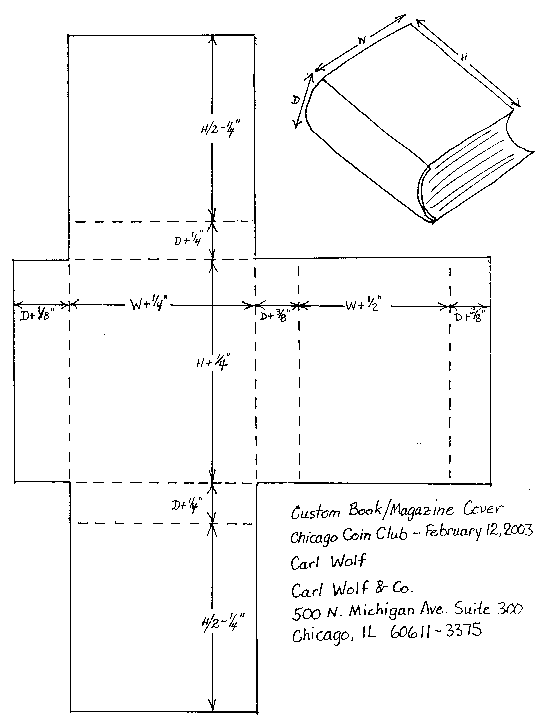
archive also available
| Chicago Coin Club | |
|---|---|
| Volume 49 No. 3 | March 2003 |
President Mark Wieclaw called the 1009th meeting of the Chicago Coin Club to order on January 8, 2003 at 7:10PM. The meeting was held at 1 Bank One Plaza.
The December meeting minutes were not submitted in time to appear in the January Chatter.
Secretary/Treasurer Lyle Daly did not give a treasury report but advised the members that there was no significant change in the balances of the accounts since last month.
There were three guests present: David Salinas, Dale Lukanich and Kevin Dailey.
First Vice President Robert Feiler introduced our guest speaker Kevin Dailey. Kevin’s talk, entitled “Napoleon’s 20 Gold Franc – The First Euro” traced the history of this nickel sized .18 oz gold coin. He illustrated how other countries within the same time frame minted coins of equivalent size and fineness, thus facilitating trade through what was essentially a unified European currency.
Robert Feiler thanked Kevin for his presentation and advised that the featured speakers medal and an ANA educational certificate will be forwarded to him.
Second Vice President Jeff Rosinia announced there were 9 attendees who were participating in show & tell. They presented as follows:
Reading of Applications for Membership:
There were no readings for membership.
Old Business:
It was noted that Jeff Rosinia and Carl Wolf would be developing a give away for the meeting held at the
Chicago Paper Money Expo on February 22. Carl is working on a speaker.
Robert Leonard is developing a give away that discusses salt and pepper money for the CICF meeting on April 26th
New Business:
Out going President Carl Wolf presented his beautifully crafted “Presidential Award” to those recipients
who were unable to attend the December Banquet.
The position of Secretary Treasurer is under review and may be split into two positions. Candidates to replace out going Secretary Treasurer Lyle Daly will be contacted. Replacements will be
President Mark Wieclaw once again noted the tremendous contribution past president Carl Wolf made on behalf of the club. Carl received a well deserved round of applause
The meeting was adjourned at 9:05 p.m.
Respectfully submitted by Lyle Daly
Presented by Phil Carrigan and Carl Wolf to our February 12, 2003 meeting.
Phil started the program with a 1951 quote from P.O. Sigler concluding "... that a collector may dispose of all or a major part of his collection during his lifetime, but that his coin books are sold by his executor." That is a great way to summarise the transition from just acquiring numismatic items to studying those items and the conditions that produced them. One result of the search for more information is a stack of books, pamphlets, articles, and other material; the start of a numismatic library.
For US coins, the Red Book and Breen's Encyclopedia provide a base of information. As a collector starts to concentrate on certain areas, information is sought in those specific areas. In addition to the key references for a series, the sources cited in the bibliographies should be learned. Not in a "memorize everything" mode, but rather at least know the chapter headings; know where specific information is located, so that it can be referenced quickly when needed.
A working knowledge of a specific area is useful when working with dealers and fellow collectors. Not just the pricing knowledge, but an appreciation of the growth and development of a specialty helps understand the current state of that specialty.
The classic books are not the only items to be included in a library. Pamphlets or monographs were produced on many specialized topics. Although a forty year old pamphlet sometimes still is authoritative, even the slightly dated ones are useful. In addition to pricing, auction catalogs provide pedigree information and summarize contemporary knowledge of items; the auction catalogs for some collections have even stood as the reference for a while. Pedigree information is also to be found in the fixed price lists (FPLs) from key dealers. The specialty club journals and newsletters provide a sense of how the specialty evolved, and should be investigated by newer members. Although electronic material currently is limited, it might be the fastest growing; but the growth is spurty and the coverage is uneven.
Phil concluded with some sources for a library. Start with the key dealers in your specialty, and subscribe to catalogs and FPLs. The serious specialized collectors and a literature collector group (Numismatic Bibliomania Society, for instance) are good aids in separating the great references from the terrible. Literature dealers (Kolbe, Davis, Lake, Grady) also are good source of both publications and information on them.
Once you have a library, you should not just put it in the attic or basement and forget about it. Carl talked about preserving a library, and he started with the quote, "Coins are your treasures, but books are your friends." There are many threats to a library, but the first mentioned was water. Of course keep your library out of the basement, but also keep it away from overhead water pipes. Closely related to water is high humidity, which can lead to mildew; a dehumidifier is not always a good defense. Bindings can fade from exposure to the sun and flourescent lights, and the sun and heat can also dry out the bindings and cause cracks. Finally, dust can imbed in the cover and page edges.
In spite of even the most detailed and careful planning, libraries suffer from wear and tear. Library supplies should be investigated to help preserve a library. Although Art Supply stores should have some acid free products, stationery stores have very little acid free products. Search for "Library Supplies" on the Internet; and when visiting related web sites, look for articles dealing with "Introduction to Preservation" and "Archival Storage." Some suggested sites were: vernlib.com, www.gaylord.com, and www.demco.com.
Continuing the theme of protecting items from handling wear and tear, Carl showed how a magazine holder can protect paper covered magazines; although great for a sufficient number of "standard size" magazines, they are not perfect when dealing with non standard size issues especially when there are not enough to fill the holder. Similarly, a standard size magazine holder would not provide much protection to an odd-sized fragile book suffering from a broken binding or other structural problems.
As a solution for those situations, Carl showed examples of a custom holder he built for use in his library. Starting with corrugated cardboard (acid free preferred), a utility cutter, a cutting board, and a steel ruler, use measurements of a book and the following template to cut the cardboard to the indicated shape. Use a dull instrument to score the cardboard ("pinch" or "crimp" the cardboard without tearing the surface), glue velcro dot fasteners as indicated, and fold the cardboard around the book; use heavy duty rubber bands to hold everything in place, until the cardboard remembers the new shape. Carl uses a screen-spline roller as his scoring tool; it looks like a pizza cutter, but instead of a sharp cirular blade the roller has a round piece of metal at least one sixteenth of an inch thick.

Presented by Douglas Ball to our February 22, 2003 meeting.
Viewing himself as an economic historian, Douglas Ball kept his state bonds when selling his other collections. His collection has grown since then, helped along by the new material that appears randomly on the market, seemingly out of thin air.
Part of that is due to how the reference works in this area were produced; the author listed all types known to him, but he had never researched archived records to see what had been authorized and issued!
Consider the life of a bond. A bond targeted for a specific use, such as building a prison, did not need a large issue to raise the desired amount; the bonds had to be turned in to have the principal returned at maturity; and the redeemed bonds were kept with the financial records of the issuer. These factors help explain why many early bonds are known through only a few specimens.
While showing a Connecticut bond paying for the new capitol building (which is pictured on the bond), Doug told a moving day story. Faced with the task of moving many records from the cellar of the old building and into the new building, it was simpler just to leave the old records curbside, for anyone to pick through; Revolutionary War items and other goodies. When the audience started moaning, Doug asked, "Where do you think all the good Connecticut material came from?" Then he related the "cleaner" solution used in Arkansas when faced with a similar moving day; they shipped all records to a facility that macerated them.
Most early bonds, especially the small issues, were printed locally; typically typeset or offset. Doug showed some Massachusettes bonds with small vignettes engraved by the local silver smith Paul Revere. After showing a simply typeset bond from Indiana, Doug could not figure out how they were not counterfeited.
Bonds were produced professionally when they were made in larger runs and more widely sold; especially starting with the Civil War. The large sums needed to raise and equip the troops were raised mostly by general obligation bonds of the states. Doug showed a Nevada bond signed by Owen Clemens, a brother of Mark Twain. After the war, ex-general Nathan Bedford Forest signed bonds of the Selma Marin Memphis Railroad. Other notable signatures on bonds were Andrew Johnson as governor of Tennessee and William McKinley as governor of Ohio.
Why were states the usual issuers of bonds, rather than private groups? Credit. The states and cities had it, and they used it increasingly to finance large-scale infrastructure projects. The first such major project was the Erie Canal, financed by bonds issued by New York city. The large resulting east-west traffic propelled New York past Philadelphia as the nation's commercial and financial powerhouse. Although Doug showed no construction bond for the Erie Canal, he showed some later issues to maintain it; such as one for re-dredging the canal.
New York's growth due to the Erie Canal inspired other localities to issue bonds for their own banks, turnpikes, canals, and railroads. Sometimes the bonds were issued by a company but guaranteed by a state, and Doug showed a number clearly stating the guarantee. But that did not stop states from repudiating some bonds, especially if the company quickly went broke after getting the money raised by the bonds. Among the repudiated bonds were issues from the Territory of Florida, and a $2000 bond of Mississippi's Union Bank signed (and soon repudiated) by the governor.
Life was hard in the territories, what with worrying about attacks from Indians and transient miners. That and their lack of a credit history made them poor credit risks. Doug showed a $100 bond from the Montana Territory paying 24%, but later ones offered only 8% due to improving credit.
Although the purchasers of the early bonds typically were local banks and insurance companies, Doug showed a Virginia bond denominated in sterling, tailored to the European market. The early bonds can be collected in many different ways: locale, proceeds of the bond issue, signatures, and vignettes are just a few. But Doug believes the background research of an issue can be the source of much enjoyment, and the audience enjoyed the well presented program. We look forward to more talks from this talented speaker.
Each image has a scale in the lower-left corner, with the tics spaced 1 mm apart. Because the brightness and contrast were manipulated on a computer, the coloring of a coin's image differs from the coin's actual coloring.

|

|

|
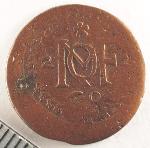
|
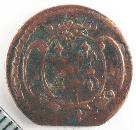
|
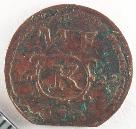
|
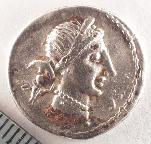
|

|
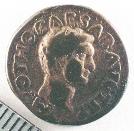
|
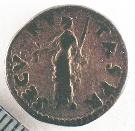
|
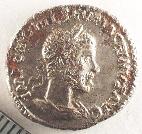
|

|

|

|
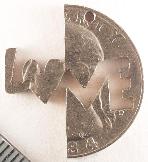
|
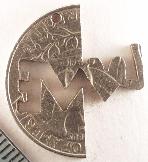
|
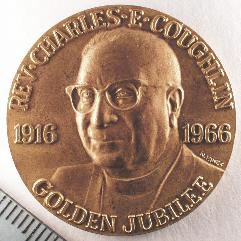
|

|
| Date: | March 12, 2003 |
| Time: | 7:00 PM |
| Location: | Downtown Chicago. Please remember the security measures at our meeting building: give a club officer the names of all your guests prior to the meeting day; and everyone must show their photo-ID at the security desk. |
| Featured speaker: | Louis Jordan - Role of Hogge Money in the Formation of the Sommer Islands Economy |
|
One of the first coinages in the New World was issued showing a hog as the primary image. They were struck in 1616 in England for circulation in the Sommer Islands. For many years these extremely rare coins were thought to be tobacco receipts. But in the past 15-years more examples have been uncovered with metal detectors. Further study is beginning to reveal that they were a token coinage for the Sommer Island Company. They circulated for about 10 years in a very primitive island economy and were replaced by tobacco because of its intrinsic value. |
| March | 12 | CCC Meeting - Featured Speaker - Louis Jordan on Role of Hogge Money in the Formation of the Sommer Islands Economy |
| Our April meeting will consist of two sessions: we will end the first session with a recess (instead of an adjournment), and we will reconvene for the second session at the CICF. | ||
| April | 9 | CCC Meeting - Featured Speaker - John Wright on 300 Years of Portraits of the Caesars as Shown on Sestertii Coinage |
| April | 25-27 | 28th Annual Chicago International Coin Fair (CICF) at the Holiday Inn O'Hare, 5440 North River Road, Rosemont. Admission is $5. |
| April | 26 | CCC Meeting - 1pm at the Chicago International Coin Fair (CICF),
which is held at the Holiday Inn O'Hare, 5440 North River Road, Rosemont, IL.
No admission charge for our meeting.
Featured Speaker - to be announced |
| April | 1 | Charles J. Ryant, Jr. | |
| April | 12 | Mark Wieclaw | 1991 |
| April | 15 | Robert D. Leonard, Jr. | 1983 |
| April | 15 | Charles Menard | 1995 |
| April | 18 | Nancy Walsh | 1997 |
| April | 27 | Don Valenziano | 1982 |
All correspondence pertaining to Club matters
should be addressed to the Secretary and mailed to:
CHICAGO COIN CLUB
P.O. Box 2301
CHICAGO, IL 60690
http://www.ChicagoCoinClub.org/
| Paul R. Hybert |
| prhybert@worldnet.att.net |
| Mark Wieclaw | - President |
| Robert Feiler | - First Vice President |
| Jeff Rosinia | - Second Vice President |
| Directors: | Lyle Daly
Mike Metras Steve Zitowsky Carl Wolf |
| Other positions held are: | |
| Robert Weinstein | - Secretary |
| Steve Zitowsky | - Treasurer |
| Paul Hybert | - Chatter Editor |
| Phil Carrigan | - Archivist |